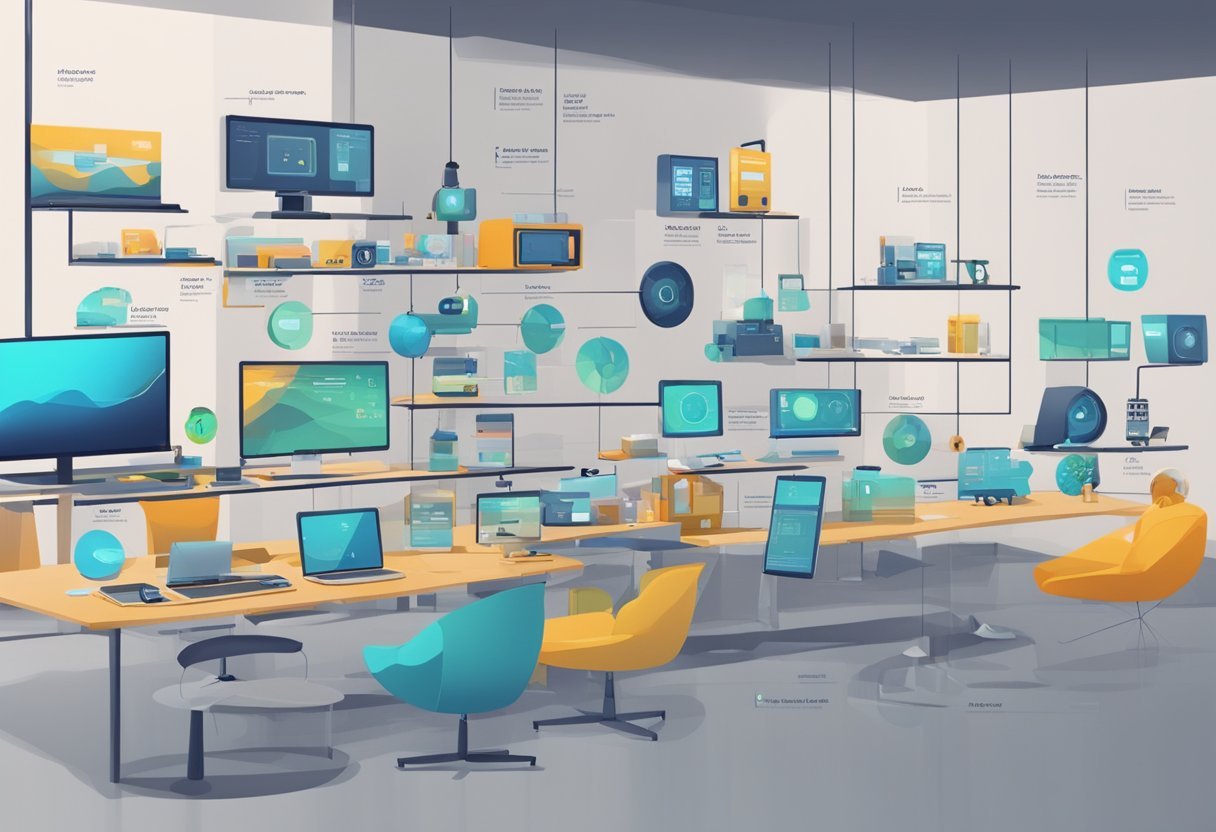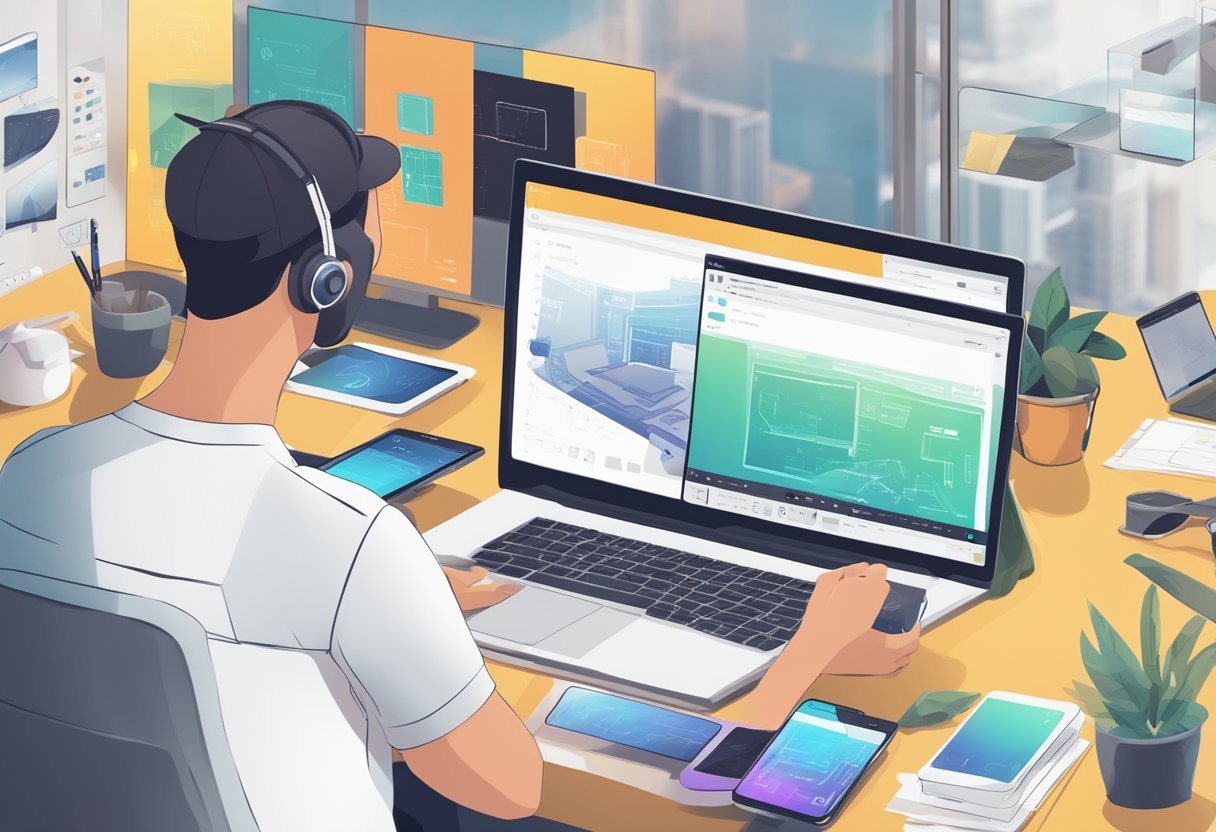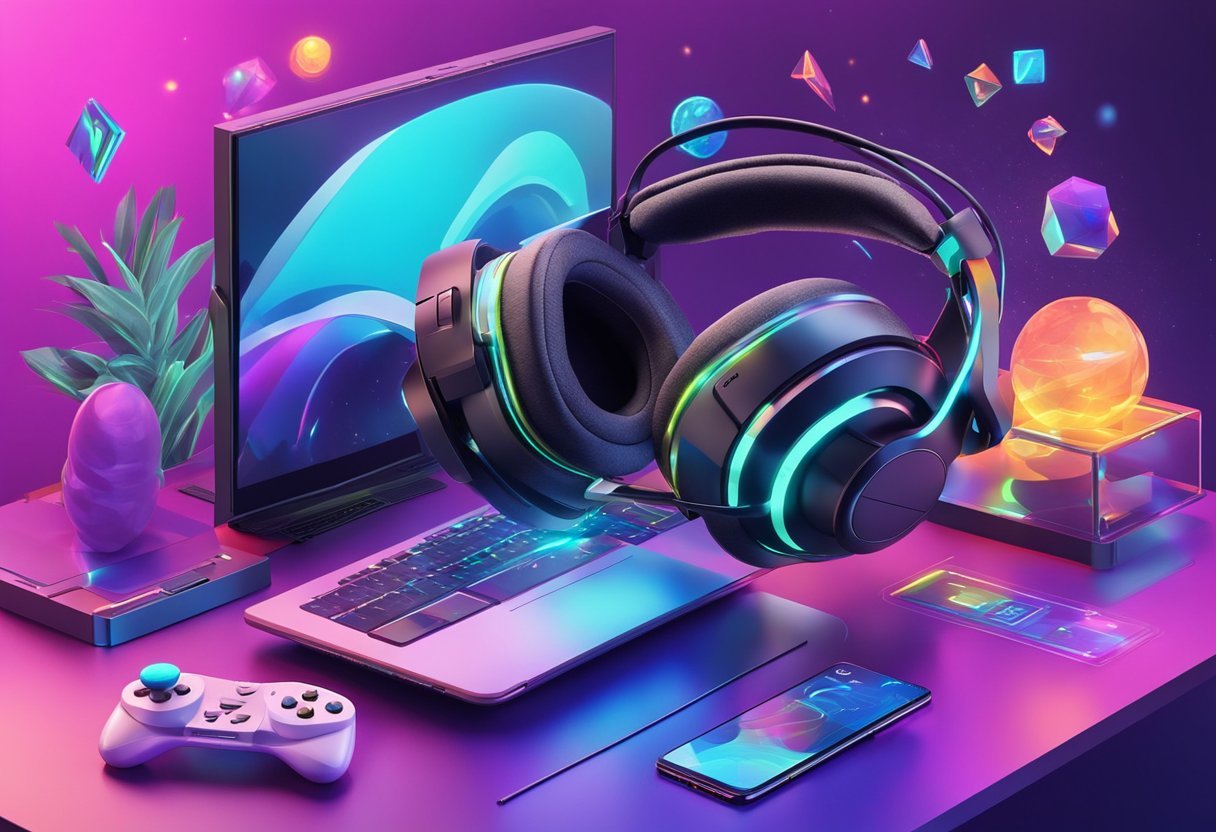Augmented Reality (AR) is a technology that has been around for years, but it has recently gained popularity due to its ability to enhance real-world experiences. AR technology overlays digital information onto the physical world through a device’s camera, allowing users to interact with the environment in new and exciting ways. With the growing demand for AR experiences, developers have created a wide range of free AR apps for users to enjoy. In this blog post, I will share with you the top 10 free augmented reality apps, their functionalities and use cases of each of these free AR Apps.
Top Free AR Apps are available for both Android and iOS devices. These apps offer a wide range of experiences, from educational to entertainment. Some of the best free AR apps include Google Translate, Houzz, and Civilisations. These apps allow users to translate texts, visualize home décor, and explore ancient civilizations, respectively. With the increasing popularity of AR technology, more free AR apps are being developed, providing users with endless possibilities for entertainment and education.
History and Evolution of AR
Augmented Reality (AR) technology has been around for several decades, but it wasn’t until recent years that it became mainstream. The first AR system was developed in the early 1990s by Boeing researcher Tom Caudell and David Mizell. The technology was initially used for military purposes, but it has since found its way into various industries, including healthcare, education, gaming, and entertainment.
AR vs VR: Distinguishing the Technologies
AR and Virtual Reality (VR) are two different technologies that are often confused with each other. While AR overlays digital information onto the real world, VR creates a completely immersive experience in a virtual world. AR allows users to interact with the real world while enhancing it with digital information. On the other hand, VR creates a simulated environment that is entirely separate from the real world.
Core Technologies Behind AR
AR technology relies on several core technologies, including computer vision, 3D modeling, and animation. Computer vision is used to track real-world objects and overlay digital information onto them. 3D modeling is used to create virtual objects that can be overlaid onto the real world.
Animation is used to create interactive experiences that respond to user input. AR technology is supported by platforms such as ARCore for Android and ARKit for iOS, which provide developers with the tools they need to create AR applications.
AR technology has come a long way since its inception in the early 1990s. It has found its way into various industries and has become a popular tool for enhancing the real world with digital information. With the continued development of AR technology, we can expect to see even more innovative applications in the future.
10 Free augmented reality app

- Google Lens
- IKEA Place
- AR Ruler App
- Star Walk 2
- Ingress Prime
- Just a Line
- Quiver
- Google Translate
- SketchAR
- NASA’s Spacecraft 3D
Google Lens
Google Lens is a versatile and powerful augmented reality app that integrates with your device’s camera to bring advanced visual search and recognition capabilities to your fingertips. It can identify objects, landmarks, plants, animals, and even products, providing relevant information, reviews, and purchase options. Google Lens also excels in reading and translating text in real time, making it an invaluable tool for travelers and anyone needing quick translations.
It can scan QR codes and barcodes, adding a layer of interactivity to everyday objects and print materials. Google Lens is particularly useful for educational purposes, shopping, and exploring the world around you through a digital lens.
IKEA Place
IKEA Place is a free augmented reality app that allows you to virtually place furniture in your space. By using your device’s camera, you can see how different items from IKEA’s catalog would look and fit in your home. This app is a game-changer for interior design, as it helps you make more informed decisions about furniture purchases, ensuring the size, style, and color match your space. IKEA Place is also a fantastic tool for visualizing room layouts and experimenting with different design ideas without the physical labor of moving heavy pieces around.
AR Ruler App
The AR Ruler App turns your smartphone into a virtual tape measure. Using augmented reality technology, you can measure distances, areas, and volumes directly through your device’s camera. This app is incredibly useful for quick measurements when you don’t have a physical ruler or tape measure at hand. It’s perfect for interior designers, architects, DIY enthusiasts, or anyone who needs to gauge the size of objects or spaces quickly and efficiently. The AR Ruler App simplifies tasks like hanging pictures, buying new furniture, or any project that requires precise measurements.
Star Walk 2
Star Walk 2 is an astronomy app that uses augmented reality to overlay constellations, stars, and other celestial bodies onto the night sky as seen through your device’s camera. This educational tool makes stargazing more informative and engaging, as it helps users identify and learn about celestial objects in real-time. It’s perfect for astronomy enthusiasts, educators, or anyone with a curiosity about the universe. Star Walk 2 can also alert you to upcoming astronomical events, making it a great companion for planning your stargazing sessions.
Ingress Prime
Ingress Prime is an AR mobile game that transforms the real world into a global game board. Players choose between two factions and compete to capture and control virtual territories that correspond to real-world locations. It encourages exploration, teamwork, and strategic thinking as players must physically move through the world to interact with ‘portals’ at places of cultural significance, such as public art, landmarks, and monuments. Ingress Prime is not just a game; it’s a social experience that fosters community and outdoor activity.
Just a Line
Just a Line is an AR drawing app that allows you to create simple drawings in 3D space using your device’s camera. It brings doodles to life, letting you draw on anything in your environment. The app is straightforward, fun, and encourages creativity and sharing, as you can record your AR drawing sessions and share them with others. Just a Line is great for artists, children, or anyone looking to add a creative touch to the world around them.
Quiver
Quiver is an educational AR app that brings coloring pages to life. Designed for children, it turns their colored drawings into animated 3D models. It’s an engaging way to blend traditional coloring activities with modern technology, making learning and creativity more dynamic. Quiver is particularly useful in educational settings, as it can help teach concepts like biology, geography, and history in an interactive manner that captures the imagination of students.
Google Translate
Google Translate’s AR feature is a powerful language translation tool that instantly translates text in the real world when viewed through your device’s camera. This feature is incredibly useful for travelers or anyone who frequently encounters foreign languages. By simply pointing your camera at text on signs, menus, or any printed material, Google Translate overlays the translation directly onto the original text, making it easy to understand your surroundings in a different language.
SketchAR
SketchAR is an app designed for artists and those learning to draw. It uses augmented reality to project virtual images onto paper, so you can trace them and practice your drawing skills. It’s a fantastic tool for art education, as it can help beginners learn proportions, compositions, and techniques. SketchAR also offers a creative platform for experienced artists to experiment with new ideas or to start a piece of art with a virtual sketch before adding their flair.
NASA’s Spacecraft 3D
NASA’s Spacecraft 3D is an educational app that uses AR to bring various spacecraft to life in 3D models. Users can learn about the different vehicles used in NASA’s space missions, explore them in detail, and understand how they operate. This app is a great educational resource for students, educators, or anyone interested in space exploration. It can also serve as an interactive exhibit for museums or classrooms, providing an immersive learning experience about space technology and the history of space exploration.
Free Education-Focused AR Applications
AR technology has tremendous potential in the field of education, providing a more immersive and engaging learning experience for students. Here are some of the best free AR apps for education:
- Mondly: This language-learning app uses AR to create a more interactive and engaging experience for users. With Mondly, users can practice their language skills by interacting with virtual objects and characters in real-world environments.
- Civilisations AR: Developed by the BBC, this app allows users to explore ancient artifacts and historical sites in 3D using AR technology. This app is a great resource for history buffs and students alike.
- Quiver: This app is designed for younger students, providing an interactive coloring experience that brings their creations to life in 3D using AR technology. Quiver is a great tool for encouraging creativity and imagination in children.
Free Entertainment and Media AR Platforms
AR technology has also had a significant impact on the entertainment and media industries, providing new and innovative ways for users to interact with content. Here are some of the best free AR apps for entertainment and media:
- Google Lens: This app uses AR technology to provide users with information about the world around them. With Google Lens, users can scan objects and images to learn more about them, including translations, reviews, and more.
- Ikea Place: This app allows users to visualize furniture and home decor in their own space using AR technology. With Ikea Place, users can see how furniture will look in their home before making a purchase.
- SketchAR: This app allows users to create and share AR art using their smartphone or tablet. With SketchAR, users can draw virtual objects in real-world environments, creating a unique and interactive art experience.
These free AR apps provide a glimpse into the potential of AR technology in a variety of fields. Whether you’re a student, history buff, or just looking for a fun and innovative way to interact with the world around you, these apps are definitely worth checking out.
Creating AR Experiences

Augmented reality (AR) is an exciting and growing field that allows developers to create immersive digital experiences that blend the real world with digital content. With the rise of smartphones and tablets, AR has become more accessible than ever before, and there are now many free tools available for creating AR projects.
Tools for AR Development
There are a variety of tools available for creating AR experiences, ranging from simple drag-and-drop interfaces to more advanced programming environments. Some popular options include:
- Adobe Aero: A free app for iOS and desktop that allows users to create AR experiences using 3D models, images, and animations.
- Blippbuilder: A free web-based tool that allows users to create AR experiences using 3D models, images, and videos.
- Zapworks: A comprehensive AR platform that includes a suite of creative tools, SDKs, and a powerful CMS for managing and publishing AR content.
Designing for Different Platforms
When creating AR experiences, it’s important to consider the platform you’re designing for. Different platforms have different capabilities and limitations, so it’s important to design your project with these in mind. For example, if you’re creating an AR project for Android devices, you’ll need to consider the different screen sizes and resolutions of different devices, as well as the different versions of the Android operating system.
Similarly, if you’re creating an AR project for iOS devices, you’ll need to consider the different screen sizes and resolutions of different devices, as well as the different versions of the iOS operating system. You’ll need to consider the different hardware capabilities of different iOS devices, such as the presence or absence of a LiDAR scanner.
Publishing and Sharing AR Content
Once you’ve created your AR project, you’ll need to publish and share it with others. There are a variety of ways to do this, depending on the platform you’re working with. For example, if you’re working with Apple’s ARKit, you can publish your project to the App Store and make it available for download to iOS users.
If you’re working with Google’s ARCore, you can publish your project to the Google Play Store and make it available for download to Android users. You can share your AR project on social media platforms like Instagram and Facebook, or embed it on your website using tools like Google Maps or Niantic’s Real World Platform.
There are many free tools available for creating AR projects, and with a little bit of creativity and know-how, anyone can create immersive digital experiences that blend the real world with digital content. By considering the platform you’re designing for and using the right tools and techniques, you can create AR projects that are engaging, informative, and fun to use.
Integrating AR in Everyday Life

Augmented Reality (AR) is a technology that has gained widespread popularity in recent years. It is a technology that overlays digital information over the real world, creating a new and immersive experience. AR technology has become increasingly accessible and is now available on smartphones, making it easier for people to integrate it into their everyday lives.
AR for Navigation and Maps
AR technology can be used for navigation and maps, providing users with a live view of their surroundings. Google Maps has integrated AR technology into its app, allowing users to see directions in real-time. With AR-enabled maps, users can easily navigate through unfamiliar areas, making it easier to find their way around.
Enhancing Shopping with AR
AR technology has the potential to revolutionize the way people shop. Furniture retailer IKEA has created an AR app called IKEA Place that allows users to see how furniture would look in their homes before making a purchase. This app uses AR technology to overlay digital furniture onto real-world environments, giving users a better idea of how a piece of furniture would fit in their space.
Educational Applications of AR
AR technology has the potential to transform the way students learn. By integrating AR technology into textbooks, students can access additional information, including videos, images, and text, making learning more interactive and engaging. Educators can also use AR technology to create immersive learning experiences, allowing students to explore and interact with virtual objects in a real-world environment.
IAR technology has the potential to transform the way people interact with the world around them. With its increasing accessibility and integration into everyday devices like smartphones, AR technology is becoming more widespread and has the potential to revolutionize the way people shop, navigate, and learn.
The Future of Augmented Reality
Augmented reality (AR) is a technology that overlays digital content onto the real world. It has been used for years in various applications, such as gaming and advertising. However, the technology is still evolving and has the potential to transform the way people interact with the world around them.
Trends in AR Technology
In recent years, AR has become more accessible to consumers through the use of smartphones and tablets. This has led to the development of new AR applications, such as virtual try-ons for clothing and makeup, and the integration of AR into social media platforms.
One of the most significant trends in AR technology is the development of wearable devices, such as smart glasses, that can display digital content in the user’s field of view. This technology has the potential to revolutionize industries such as healthcare and manufacturing by providing workers with real-time information and instructions.
The Role of AR in the Metaverse
The real-world metaverse is a concept that envisions a virtual world that is seamlessly integrated with the physical world. AR has the potential to play a significant role in the development of the metaverse by providing users with a way to interact with digital content in the real world.
As the metaverse continues to develop, AR technology will become more advanced, allowing users to interact with more complex and realistic digital content. This will lead to new opportunities for brands to engage with their audience, such as creating immersive experiences that blend the physical and digital worlds.
Ethical Considerations and Privacy
As with any technology, there are ethical considerations and privacy concerns associated with the use of AR. For example, the use of AR in advertising raises questions about the extent to which brands can collect and use data about their audience. To address these concerns, it is essential that developers and brands take a proactive approach to privacy and ethics. This includes designing AR experiences that are transparent about the data they collect and how it is used.
AR technology has the potential to transform the way people interact with the world around them. As the technology continues to evolve, it is essential that developers and brands consider the ethical implications and take a proactive approach to privacy and data collection.
Frequently Asked Questions
What are the top free AR apps for both Android and iPhone?
There are many free AR apps available for both Android and iPhone. Some of the most popular ones include IKEA Place, which allows users to place virtual furniture in their homes; AR Ruler, which measures objects using augmented reality; and Google Lens, which can identify objects and provide information about them. Other popular free AR apps include Pokemon Go, Snapchat, and Instagram.
How can beginners create augmented reality content without cost?
Beginners who want to create augmented reality content without cost can use free AR creation tools such as ARToolKit, AR.js, and Unity. These tools allow users to create AR content using 3D models, animations, and other digital assets. There are many online tutorials and resources available that can help beginners learn how to create AR content.
Are there any educational AR applications available for free?
Yes, there are many educational AR applications available for free. Some of the most popular ones include NASA’s Spacecraft AR, which allows users to explore spacecraft in augmented reality; GeoGebra AR, which helps students learn math concepts using augmented reality; and AR Flashcards, which helps children learn words using augmented reality.
Does Google offer a no-cost augmented reality application?
Yes, Google offers a free augmented reality application called Google Lens. Google Lens uses augmented reality to identify objects and provide information about them. It can also translate text, scan barcodes, and recognize landmarks. Google Lens is available for both Android and iPhone.
What options exist for experiencing augmented reality without downloading apps?
There are several options for experiencing augmented reality without downloading apps. One option is to use a web-based AR platform such as AR.js or 8th Wall. These platforms allow users to experience augmented reality using their web browsers. Another option is to visit museums or other public spaces that offer AR experiences.
Where can I find augmented reality software for free download?
There are many websites that offer free downloads of augmented reality software. Some of the most popular ones include GitHub, Unity Asset Store, and Vuforia. However, it is important to be cautious when downloading software from the internet, as some downloads may contain viruses or malware. It is recommended to only download software from trusted sources.




